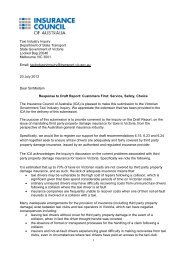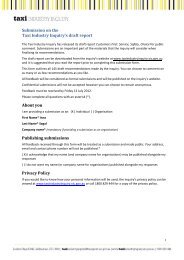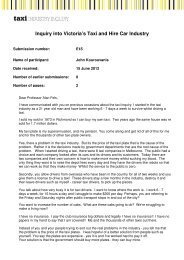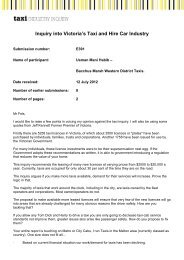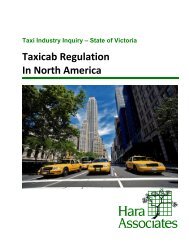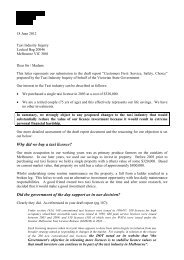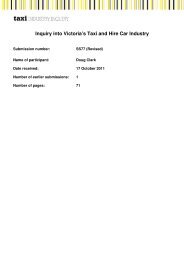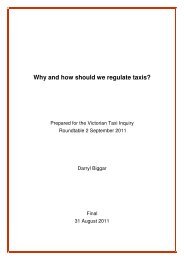Part D â Understanding and improving industry performance (PDF ...
Part D â Understanding and improving industry performance (PDF ...
Part D â Understanding and improving industry performance (PDF ...
Create successful ePaper yourself
Turn your PDF publications into a flip-book with our unique Google optimized e-Paper software.
Case study<br />
Northern Territory – Deregulation<br />
In 1999, following the National Competition Policy review, the Northern Territory became the first <strong>and</strong> only<br />
jurisdiction in Australia to remove quantity restrictions on taxi licences.<br />
The approach to deregulation in this instance constituted a licence buy-back <strong>and</strong> reissue scheme:<br />
• Existing licences were bought back at a price based on the last tendered price of a taxi licence in the particular<br />
area plus CPI – in Darwin the price was $95,000 per licence.<br />
• Licences were then reissued on dem<strong>and</strong> (no quantitative limit) for an annual licence fee – the annual licence<br />
fee in Darwin was $16,000 – with this cost planned to be removed after the costs of ‘compensation’ (that is,<br />
the initial buy-back) were recouped.<br />
However, the annual licence fee has remained <strong>and</strong> continues to be charged some 13 years after the initial removal<br />
of supply restrictions.<br />
Taxi numbers increased immediately after deregulation, <strong>improving</strong> taxi availability. However, by the end of 2001<br />
<strong>and</strong> with the election of a new government, the open entry regime was quickly reversed <strong>and</strong> a temporary cap<br />
on the number of commercial passenger vehicle licences put in place. The new Northern Territory Government<br />
cited poor returns <strong>and</strong> poorly trained <strong>and</strong> motivated drivers as the main reason for this reversal. Interestingly, the<br />
Government also declared that the reversal was needed before specific issues relating to poor quality st<strong>and</strong>ards<br />
were addressed. This cap has since been made permanent for Darwin <strong>and</strong> Alice Springs, with open entry<br />
permitted elsewhere.<br />
While some commentators cite the upheaval following deregulation in the Northern Territory as an argument<br />
against open entry regimes, the somewhat hasty <strong>and</strong> short-sighted reversal of deregulation in this case may not<br />
have allowed the benefits of deregulation enough time to filter through the system to consumers.<br />
9.3.5. Innovation<br />
Regulation should not inhibit the growth of new<br />
services <strong>and</strong> innovation. Flexibility in regulating<br />
taxi services post-deregulation is important to<br />
maximising the consumer benefits expected to<br />
arise from competition <strong>and</strong> efficiency gains resulting<br />
from the removal of licence <strong>and</strong> fare restrictions.<br />
For example, in terms of fare controls, the OECD<br />
observed that “if price regulation is to be retained care<br />
must be taken to ensure that it does not inhibit the<br />
development of premium services or, on the other<br />
h<strong>and</strong>, of shared ride arrangements.” 18<br />
New Zeal<strong>and</strong> provides a good example where, after<br />
libealising entry <strong>and</strong> fare controls, service innovation<br />
flourished, with the introduction of specialised services,<br />
innovative payment systems <strong>and</strong> advertising. 19<br />
In contrast, deregulation in US cities in the 1970s<br />
<strong>and</strong> 1980s apparently led to little innovation or the<br />
introduction of price-service combinations in the taxi<br />
<strong>industry</strong>. This highlights a need to actively focus on <strong>and</strong><br />
facilitate competition <strong>and</strong> innovation in an open market.<br />
18 OECD (2007), Op. Cit., p.43<br />
19 Soon, J. (1999), ‘Taxi!! Reinvigorating competition in the taxi market’,<br />
Issue Analysis, Centre for Independent Studies, NSW, p.7<br />
9.3.6. Making the transition<br />
The experiences of jurisdictions that have liberalised<br />
taxi licences suggest that the design of transitional<br />
arrangements is important.<br />
The inquiry observed that, in many cases, it takes<br />
some time for competition <strong>and</strong> efficiency outcomes of<br />
liberalisation to be realised. While many jurisdictions<br />
experienced significant periods of unrest in the aftermath<br />
of liberalisation, sometimes resulting in a regulatory<br />
void in cases where deregulation was wide-reaching<br />
<strong>and</strong> occurred immediately, the long-term results have<br />
generally been positive. This reinforces discussion in the<br />
previous sections about the importance of a supportive<br />
regulatory environment during efforts to deregulate.<br />
The inquiry is also aware that jurisdictions can take<br />
different approaches to the timing of reform, primarily<br />
electing to either adopt an immediate or staged<br />
approach to reform.<br />
168





